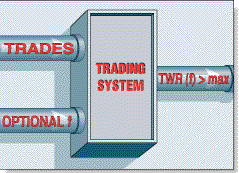MONEY MANAGEMENT
Secure Fractional Money Management
by Leo J. Zamansky, Ph.D., and David C. Stendahl
Here's how to find a new fractional value of capital to invest in every trade to maximize returns subject to a constraint on drawdown, using a variation of the optimal f money management strategy.
Over the past four years, we have developed and applied evaluation software to trading systems that use money management techniques and have studied the impact of these techniques on trading systems. A new money management strategy called secure f is one of the outcomes of that work, and here, we will demonstrate how to find a new fractional value of capital to invest in every trade to maximize returns subject to a constraint on drawdown. Secure f can be a conservative strategy or an aggressive one, depending on the level of acceptable maximum drawdown selected by the trader in question. It is a modification of the optimal f strategy that was introduced by Ralph Vince in his Portfolio Management Formulas. Secure f differs from optimal f because it takes historical drawdowns into account and uses information about the prices of the underlying security.
Optimal f is a money management strategy that can be used to improve and maximize system performance by finding the best percent of capital to invest in each trade. This strategy determines which percent of equity invested in a trade would have yielded the highest return based on a sequence of past trades. Because traders are able to employ a variety of money management strategies, it can be useful to know what would have been the optimal amount to invest in each case. The concept of percent or fractional strategy itself comes from the Kelly formula, which estimates the percentage of your capital to trade when the amounts won and lost are not equal:
b = Ratio of the size won on a winning bet to the size lost on a losing bet
p = Probability of a winning bet
A simple example would be if you had three bets -- two winners and one loser (1, 1, zero) -- and you made or lost equal amounts:
This formula solves for f. This formula is applicable when there are only two outcomes. For traders, there are many outcomes. Vince introduces optimal f, and to find the value of optimal f, we need to maximize what Vince calls terminal wealth relative (TWR). The problem can be formulated thus:
TWR(f) -> maxFigure 1 illustrates the optimization problem solved by optimal f. As we can see from the description of optimal f and Figure 1, optimal f maximizes the final equity by investing the right amount in every trade. This amount is f% of the existing equity at the time the trade is initiated. To find the value of optimal f, the calculations are applied to a set of historical trades. Trade history should be profitable; otherwise, neither optimal f nor any other strategy will turn a losing strategy into a winning one. The longer optimal f is used, the more final equity will result from its application.where TWR(f)=(HPR1(f))((HPR2(f))(...(HPRn(f))
HPRi(f)=1+(f((-Return on the trade i)/(Return on the worst losing trade))
HPR = Holding period return

FIGURE 1: OPTIMAL F. The goal is to use optimal f to manage the trading capital so that the terminal wealth relative is maximized.
Secure f money management strategy offers traders the ability to maximize the return subject to the level of risk they are willing to assume.